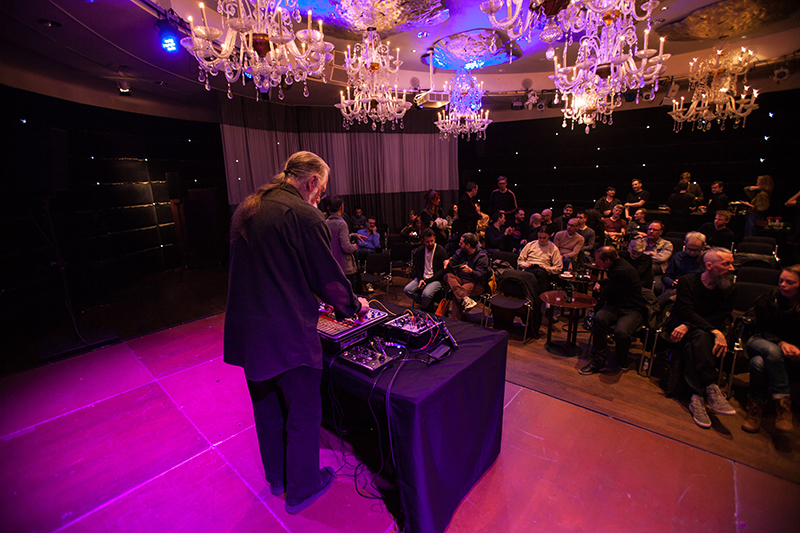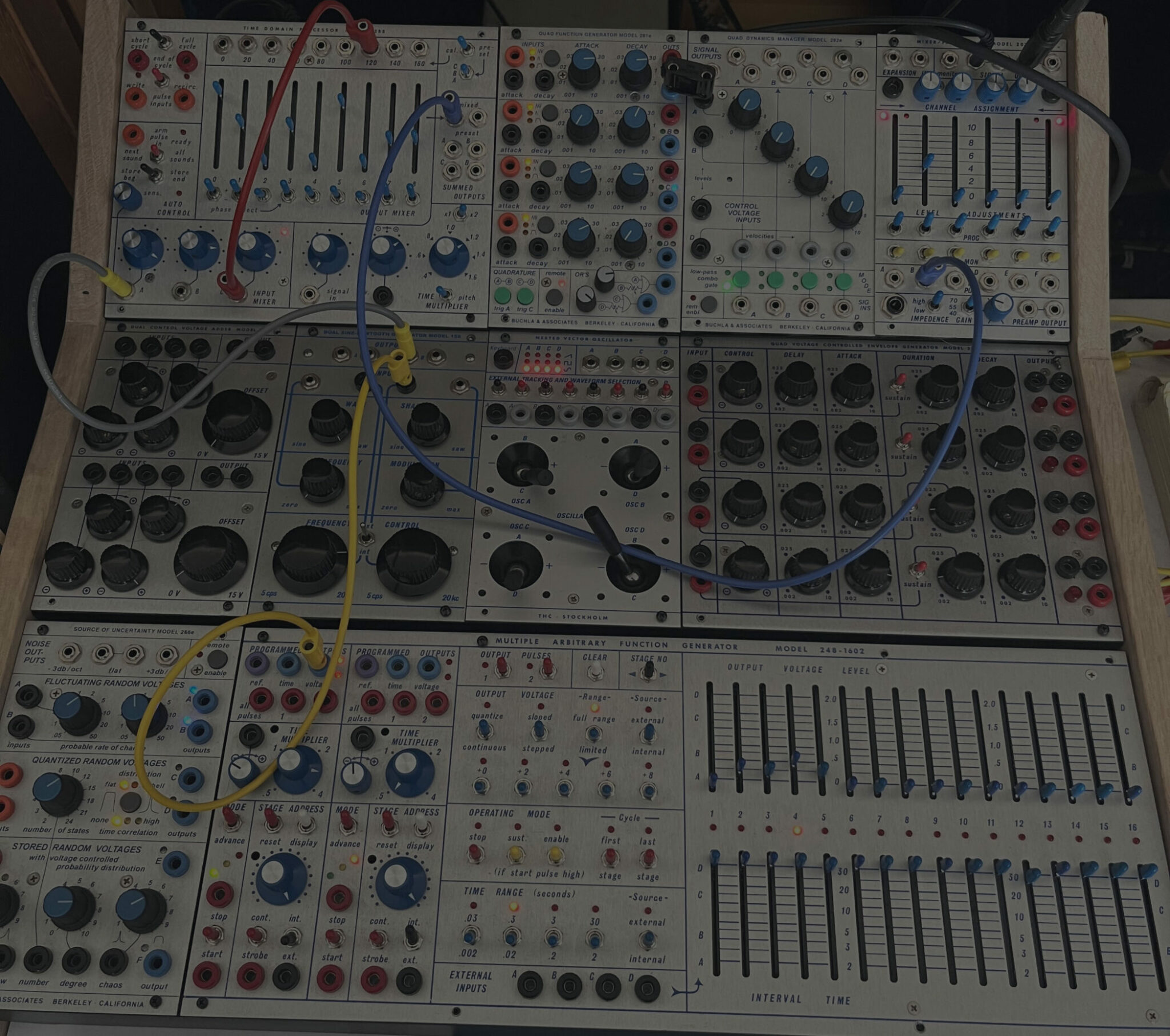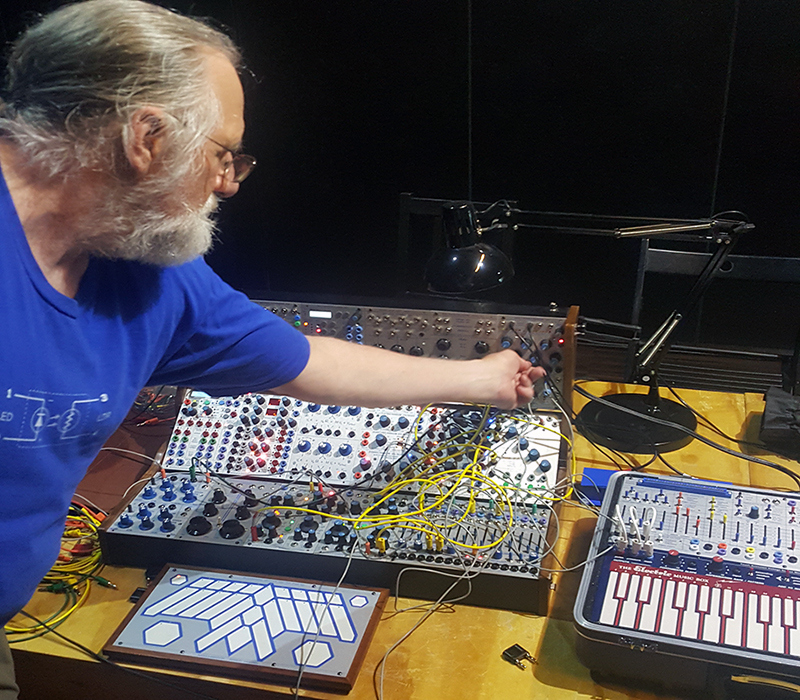
Since 1979 Todd Barton has been exploring analog and computer-based music. He is still delving deeply into the ever-expanding frontiers of musical expression: from his DNA derived Genome Music to his innovative scores for plays at the Oregon Shakespeare Festival; from performances of Zen Shakuhachi Meditation Music to avant-garde music for electronic synthesizers and computers; from performing with luminaries of jazz and poetry to lecturing on music and composition from the Middle Ages to the 21st Century.
He’s been with us since the early days of Modulisme, gracing us with one of our first Sessions :
https://modular-station.com/modulisme/session/6/
As well as contributing to most of our collections, Serge -o- Voxes, Buchlaïsms, 3 Year Itch Birthday samplers, our Reciprocess series in duo with his friend Bruce Bayard:
https://modular-station.com/modulisme/session/52/
With great pleasure we welcome him back on board with these « Simple Studies in the Buchlidian Paradigm » emphasizing choices to shorter forms :
« I love short, seemingly simple forms like haiku poetry, single brushstroke sumi-e paintings, and short stories. »
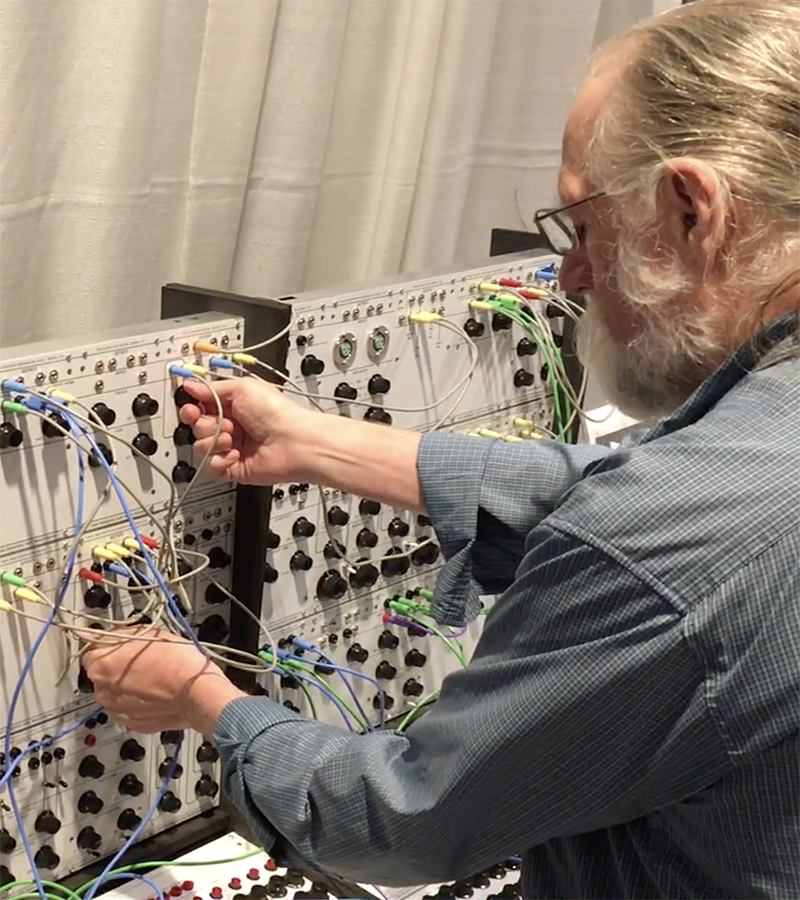
To me « Simple Studies in the Buchlidian Paradigm » comes as a perfect opposite to the « Buchla Bricolage », we had featured on our Buchlaïsms 7.
A large-scale composition made up from “what’s at hand.” gathering sounds and sonic gestures to develop them as a longer composition whereas « Simple Studies » emphasize choices to shorter forms. Why?
I love short, seemingly simple forms like haiku poetry, single brushstroke sumi-e paintings, and short stories. I think this may come from my 40 years of composing music for the dramatic stage: writing short music/sound cues that intended to propel the plot of a play. In other cases, my cues served as a way to transition from one mood to another, blend scenes together, or cover the sound of pneumatic stage elevators. I remember a fellow theater composer saying, “What we do is like postage stamp art.” We put as much thought, feeling, and intention into a 30 second music cue as we would for a larger, longer work.
I have to admit that I’m interested in short forms and for some years now I’ve often played and recorded them with the idea of putting them together in an album, but in the end never leaving them as they are. I haven’t yet reached the kind of maturity that would allow me to be satisfied with them, so how do you go about it?
I often begin with a single tone or sound object and let it lead. I follow it, try to listen into its structure, and attempt to feel where it is going. There is no rush, no need to “direct” the experience. There is a sense of “beginning” which then unfolds and eventually ceases. It is a little life-form. I don’t necessarily start with the idea of “I’m going to do a short piece.” The piece dictates its limits (or maybe I just have a short attention span.
😉
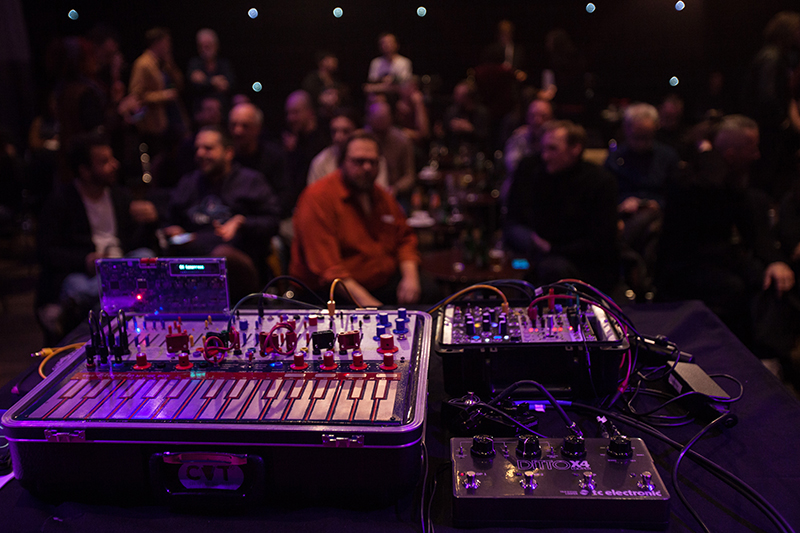
How do you tell the difference between a recreational play process and pure compositional thought?
Woah?! You mean they are different? Hehehe!
Music creation has always been fun and playful for me since childhood. I’ve always felt connected to sounds, both physically and emotionally. When I read the words “pure compositional thought”, I feel detached from the experience of sound; and that detachment frankly scares me. To my mind, there is nothing “pure” about composing. Composing is playful, sloppy, scary, frustrating, and filled with discoveries, self- doubt, and learning about one’s self. Nothing pure there. And “pure- thought” again seems like an oxymoron. “Thought” to my mind is more akin to what Buddhists call, “monkey mind”. Darting about, grabbing at ideas, opinions, and judgements rather than just being with silence, or in the case of composing: being with the sound and the silence.
Well, I meant « pure » as a difference between the immediate pleasure of playing and the more laborious side of producing sound while trying to follow a story, a compositional process, like managing to preserve a minimalist feel?
Again, being with the sound and following the sound is, for me, beyond the dichotomies of pleasure vs. labor.
How to « less is more » when so much is possible in front of a Buchla 200 system?
I always start with a single module and ask, “what if?” What if I turn this knob or flip this switch or do both at the same time? And thus the discovery begins and eventually the “what ifs” go to connecting another module, and slowly things develop from there.
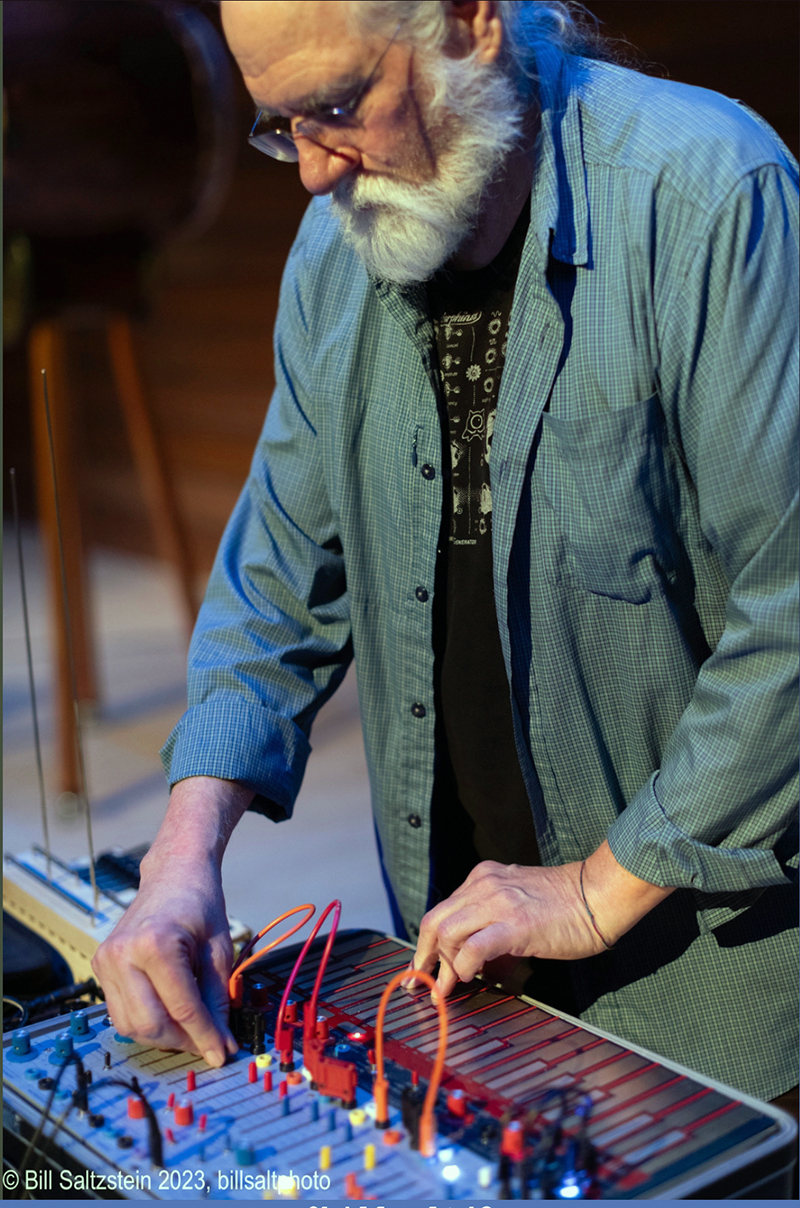
How were you first acquainted to Modular Synthesis? When did that happen and what did you think of it at the time?
My first encounter was with a Buchla Music Easel that my friend Doug Leedy handed me and let me explore for a few days back in the mid-1970s.
At that time I had no idea what I was doing, just plugging in patch cords, moving sliders, and twisting knobs, hoping to get a sound. Eventually sounds came. I was smitten with the ability to alter timbres and create sounds from scratch.
When did you buy your first system? What was your first module or system?
I got my Serge Modular Music System in 1979.
How long did it take for you to become accustomed to patching your own synthesizer together out of its component parts?
My first modular was a three-panel Serge system built by Serge and his team (Darrell and Paul) in 1979. There was no manual, so that first week or so I was spending hours a day getting no sound or little snippets of sound, not knowing what to connect. I was living, as I still do, in Ashland, Oregon. At that time, there was no one within hundreds of miles that knew anything about synths or modulars, so I was on my own. It probably took me a good month and hours each day to barely get a grip on how this instrument worked. I eventually created my own patch sheets and mapped out my daily explorations that I recorded on a cassette tape.

Recently hearing a tape you had sent to Serge Tcherepnin back in 1982 which was very minimal, demonstrating the use of some of his modules I wonder how you decide to play the Buchla or the Serge, and actually sometimes your Hordijk system?
Ah, it’s a mystery. Ok, not really 🙂 They are such different instruments that I know intimately, so it depends on my mood and also on the “what if” questions I might be asking that day or week. It is not unlike my gravitating toward the acoustic instruments I am intimate with: shakuhachi, Baroque recorder, or waterphone.
Or the Shakuhachi? Do you ever mix it with modular?
Yes, it is a particular dialog that I periodically take up.
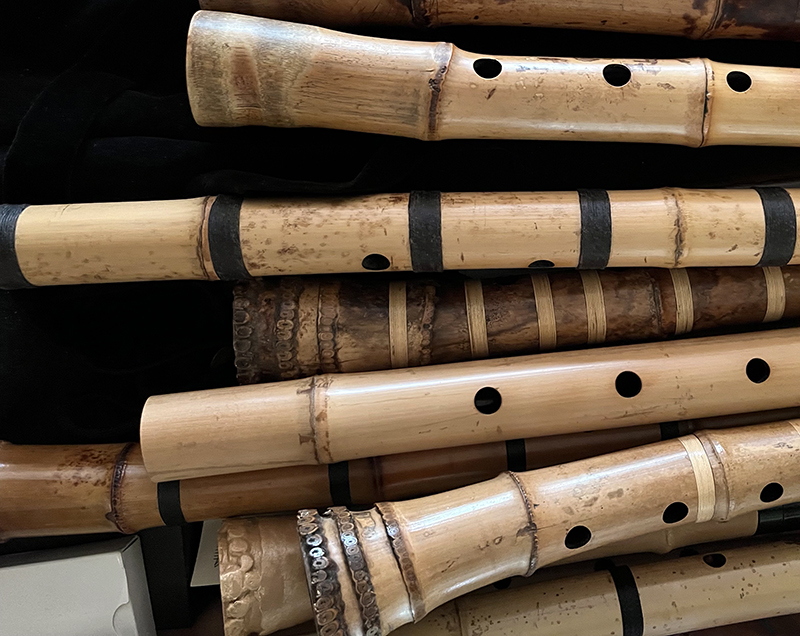
Your compositions have been performed by some Orchestras, Choirs, Quartet. Would you tell us about those works that I have never had a chance to hear? For instance composing for Kronos Qt., how do you approach the symbiosis of the Electronic and the acoustic? Why is a work like « Aleatoric Orchestral » electronic only?
Before my introduction to electronic music, I was composing for small chamber ensembles, jazz bands, soloists, and choirs; so that has always been a part of me. I met the KRONOS Quartet in 1982 when they were passing through Ashland. That lead to them coming the next year to do a couple of concerts at Southern Oregon University, including a couple of premiers of my compositions. That further led to working together on my score for the stage play of Dracula, produced by the Oregon Shakespeare Festival.
This was followed by scores for the play productions of “Peer Gynt”, which was scored for 3 KRONOS quartets (overdubbed) and the play “Breaking the Silence”.
I’m always fascinated by sounds and how to sculpt them, no matter what the medium.
I am a big fan of Hiroshi Teshigahara whose best movies were scored by Toru Takemitsu whom you quote as an influence. Have you ever been interested in scoring movies or are you put off by the lack of freedom?
I love the marriage of moving image and sound, especially abstract images.
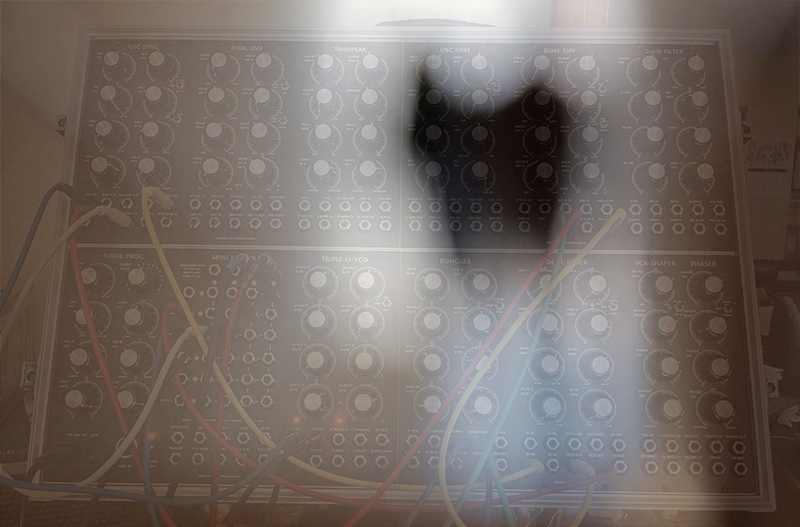
Deeply influenced by the Forbidden Planet movie you initiated a series documenting Krell music, based on cybernetic patch allowed by uncertainty? Could you develop on that concept please?
Yes, I’m totally taken with the Barron’s conceptual approach to their cybernetic compositions. They created little vacuum tube circuits based on the diagrams and descriptions found in Norbert Wiener’s book « Cybernetics: Or Control and Communication in the Animal and the Machine » (1948). These little circuits would slowly warm up, producing no sound at first (so Bebe and Louis waited, sometimes hours), then a soft sound would emerge as the feedback grew. It would go through a complete sonic lifecycle; fibrillating, screaming, moaning, and eventually either end in a fizzle or a bang. They would record all of these, hundreds of them, then collage them to create the sonic world of Forbidden Planet. One particular sound cue for that film was the music of the “Ancient Krell” society.
My Krell patch is an homage to their conceptual music and inspiring imagination. The patch does not emulate or even try to emulate their sounds, rather it is a control voltage feedback patch that, unlike their circuits, could play endlessly. What I am continually trying to explore when I do Krell patches is finding a way to have varying articulations, dynamics, and silences, while encouraging it to breathe.
Is that your favorite way to « Follow the sound » ?
No favorites, each sound unfolds in its unique way.
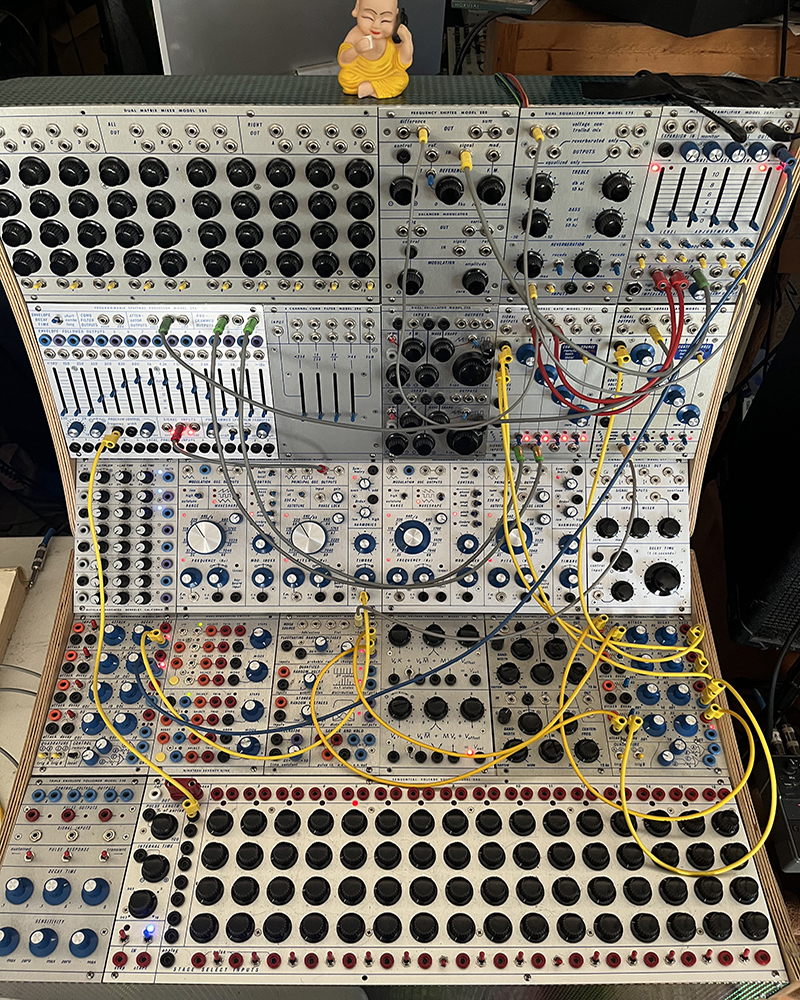
You prefer single-maker systems, why not making your own modular synthesizer out of individual components form whatever manufacturer that match your needs?
My background before electronic music was that of an acoustic performing musician, not unlike (and I’m surely not comparing my abilities to them) Morton Subotnick, who was a clarinet soloist that played in orchestras. Pauline Oliveros was a French horn player (in fact that’s how Mort and Pauline met playing in the same SF Bay Area orchestra). David Tudor was a concert pianist, Suzanne Ciani was a pianist, and Sarah Belle Reid was a classically trained trumpet player. Bana Haffar was an electric bass player, and the list goes on… My point is, we all came to electronic music as acoustic performers. I’m guessing we unconsciously approached these new electronic music systems as “instruments”, which means we were programmed to spend hours, days, weeks, and years learning to play them.
Don Buchla and Allen Strange described a patch as an “instrument definition” and assumed, I think, that one would live with a single instrument definition and learn its strengths and weaknesses much like one would an acoustic instrument.
I believe there was a sea change with the emergence of digital synthesizers in the early 1980s. We can look at the Yamaha DX7 for instance; it began a generation of menu diving and scrolling through presets until you found something you liked. We became consumers of sound rather than cooks or chefs. We might tweak a preset, but very few created an entirely new set of presets, and if they did they would sell them. Out of this new paradigm, the analog revival happened 20 years later in the early 2000s. Now the culture had been used to instant gratification and the purchasing of sounds. That said, this next leg of the global modular journey is going to be fascinating and exciting to observe. The next generation is creating its own history while integrating and mixing modular systems in a completely different approach. Earlier I mentioned consumers vs. chefs; my guess is the future will be “synthesist” in its original meaning:“the combination of parts, or elements, in order to form a more complete view or system.”
Why do I like single-maker systems? Because I love digging into their heart and soul, and having a relationship that seems endless in discovery and curiosity. For example, I’m still discovering new sounds, routings, and delights within the Buchla Easel.
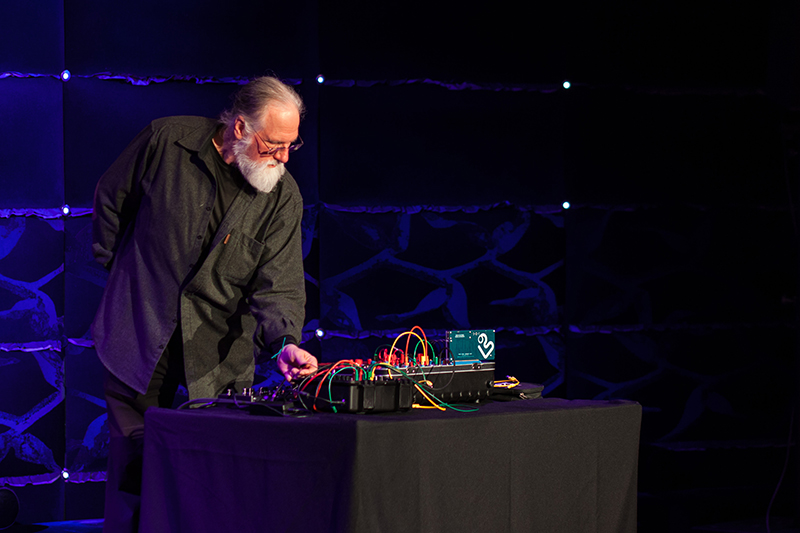
I know you attach great importance to the texture, organic side of the Buchla sound, and how the Easel can be used like an acoustic instrument. Could you please develop?
From what I understand, Don was not interested in recreating emulations of existing acoustic instruments (piano, guitar, trumpet, etc). He was fascinated by the acoustic quality and psychology of all sounds and wanted to develop and offer an instrument that had the responsiveness and resonance of the acoustics. He wanted an instrument that created un-before heard sounds with acoustic qualities.
The Easel is quite the instrument, and being a self-contained semi modular electric music box, it begged to be performed as an instrument. For me, it allows for both deep control of sound objects and surprise. The touch plates are so responsive that one needs to spend a lot of time learning the technique of pressure (body capacitance) not unlike the time necessary to learn the subtleties of a violin. Like a violin, I find both my hands are continually active, be it one on a touch plate and the other on a slider or switch.
Quite often modularists are in need for more, their hunger for new modules is never satisfied? You owning an impressive amount of gear, how do you explain that?
Though I have a lot of systems, they have been accumulated over 40 years. I spent 10 years just with my 3 panel Serge, getting to know it intimately. Even knowing it intimately, as with any relationship, the learning never ends; rather, it is self-propelling. I acquired more gear mainly in the ‘80s when folks were abandoning analog synths/ modulars in favor of digital synths. They just gave me their analog synths! Great way to build a collection! As I got more gear, I devised ways to spend time and build a relationship with each one.

Instrument building may actually be quite compositional, defining your sonic palette, each new module enriching your vocabulary. Would you say that their choice and the way you build your systems can be an integral part of your compositional process? Or is this the other way round and you go after a new module because you want to be able to sound-design some of your ideas?
Since I compose and follow sound using cohesive instruments, I’m not really buying new Hordijk, Buchla, or Serge modules. I’m more of the David Tudor school of thought:
“I try to find out what’s there—not to make it do what I want, but to release what’s there. The object would teach you what it wants to hear.”
Again, I’m interested in discovery and listening to what’s in front of me rather than reaching for some new object.
Would you please describe the system you used to create the music for us?
Each piece uses a specific system: Buchla Music Easel, Buchla 200e, Buchla 200 Electric Music Box, or the Buchla Dodeca instrument.
Can you outline how you patched and performed your Modulisme session?
I have the luxury of being retired, so everyday I’m in the studio exploring and experimenting. Often I record these experiments/ studies with a performance-like focus. My intention is trying to make each gesture musical and connected to the next one. The patches come and go almost hourly, so there is no record of the specific patches for these pieces. For the most part they are simple, allowing me to perform in real time.

Do you find that you record straight with no overdubbing, or do you end up multi-tracking and editing tracks in post-production?
Single pass for these pieces, and I often use a looper to build up textures/layers in real time.
Other works such as my “Buchla Bricolage” from “Buchlaïsms VII” took weeks of layering, editing, and creating new connective sonic tissue.
Do you pre-patch your system when playing live, or do you tend to improvise on the spot?
I follow the sound. . .
Which module could you not do without, or which module do you you use the most in every patch?
Hmm. . . curious question. Each instrument/system/patch is a complete ecosystem. The single conceptual module it could not be without is the “sound source”, which could be an oscillator, a spring reverb in feedback mode, no-input mixer, etc.
What do you think that can only be achieved by modular synthesis that other forms of electronic music cannot or makes harder to do?
Surprises!
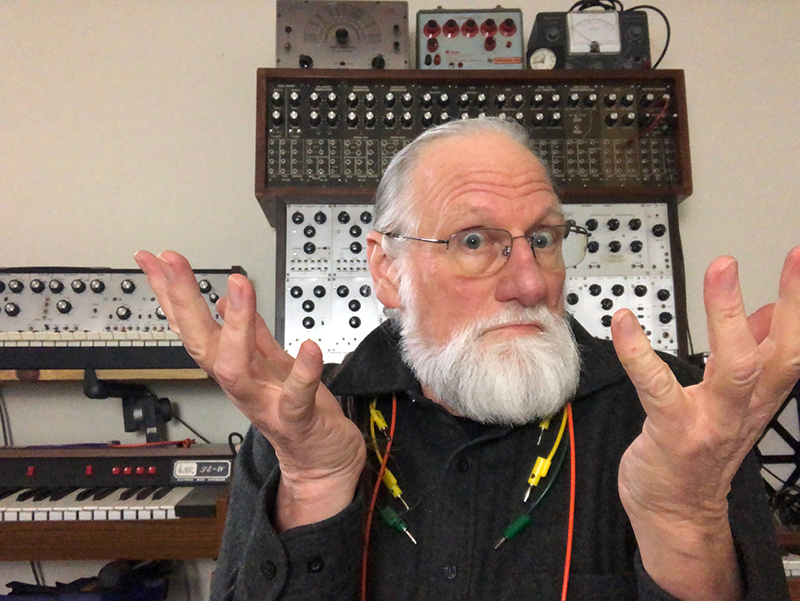
Have you used various forms of software modular (eg Reaktor Blocks, Softube Modular, VCVRack) or digital hardware with modular software editors (eg Nord Modular, Axoloti, Organelle), and if so what do you think of them?
Not really. The only digital synthesizer software I have really delved into is Metasynth, from U&I Software.
I spent years with it when it first came out and used it extensively in many of my scores for the stage and my Metascapes album.
What have you been working on lately, and do you have any upcoming releases or performances?
I recently co-curated and contributed a track to an amazing album devoted to feedback with a stellar lineup of composers.
My colleague, Bruce Bayard, is doing an audio/visual extravaganza every Saturday in May and the first two Saturdays of June with his visuals; he and I performing on Easels with a different guest artist each week.
I co-wrote a chapter in an upcoming sound design book from Routledge with my colleague Dr. Adam Hulbert. The chapter focuses on the Buchla-Serge paradigm.
How do you approach live these days? Do you still need an interaction with an audience or are you happy with studio work?
Ah, ever since those years of the pandemic, the distinction between “live performance” and “studio performance” has somewhat blurred. During the pandemic I did a lot of live streaming performances from my studio, and these days if I want a live virtual audience, I can set up my smartphone and broadcast live on Instagram. That said, there surely is nothing better than performing for an audience in a wonderful acoustical space where everyone is breathing the same air and feeling the sounds together.
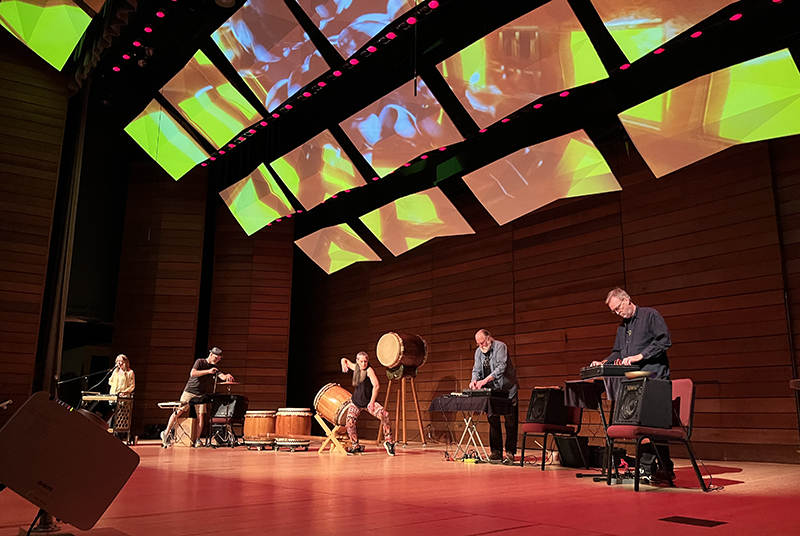
You have been a Consulting Artist for Buchla Electronic Musical Instruments , what does this mean?
Do they send you prototypes to test? Do they take your wishes into account? Your impressions? Or do they simply hire you to demonstrate a finished product?
I was a Consulting Artist for Buchla Electronic Musical Instruments from 2012 until it became BuchlaUSA.
At BEMI I was not on retainer; it was a casual arrangement whereby I could give input on new modules, especially the Aux Card for the Easel and a few other modules. I would beta test and do demos at NAMM and Knobcon. With BuchlaUSA it was a similar arrangement.
For you, Don Buchla fundamentally and universally changed the way we hear and listen to electronic music and you have been advocating the architectural difference between a Buchla module and all other synthesizer formats, separating Audio Signals (carried by tini-jax cables) and Control Voltages/Pulse/Triggers (carried by banana cables). Buchla chose a higher voltage, 15V instead of today Eurorack’s. Do you think he’d have been happy with his creation being adapted to such « mass standards » ?
There is no way I could ever speak for Don or probe his preferences or opinions. I do know that he was always inventing new things on many fronts. From what I’ve heard from his friends and colleagues, he never looked backward, only forward to what his next new idea/creation could be.
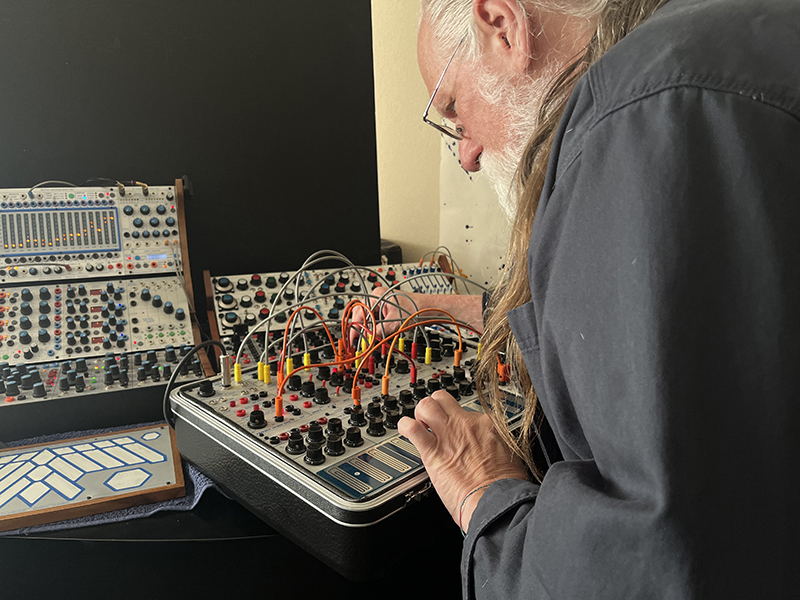
It is now a fact that a company like Behringer has chosen to focus on quantity over quality, cutting costs and choosing cheap components in order to sell for less, which in capitalist terms means selling more for less. The good excuse is to put the instrument within everyone’s reach, which works in a society where most listeners don’t care about quality, preferring the compressed format, and in fact don’t even hear the drop in frequency quality, harmonics, etc… As someone who sculpts sound, you’re bound to hear a difference in rendering and quality between the Tip Top Buchla format and the modules as they were ‘normally’ produced, aren’t you?
Yes, we’re back to consumers vs. chefs. Those that want to have food prepared for them rather than learning the art of cooking. That said, getting the tools and ingredients into folks’ hands can be a start to learning to cook. Then it is up to the individual if they want to be a quotidian or gourmet chef.
Re: Tiptop Audio Buchla modules. I’m very impressed not only by their build quality and sound, but also by the team of engineers that CEO Gur Milstein has put together. They are deeply committed to the Buchla aesthetic and philosophy of the 200 system. The only difference in sound might be that, since they are being produced in relatively larger quantities than Don did back in the 1970s, they are more consistent and stable; but they respond like the Buchlas I know and love. Don, I’m guessing, wanted his modules to respond and feel the same, but he was continually tweaking with them.
For instance, the 258 Dual Sine-Saw Oscillator had at least 5 different incarnations and the FM circuits were slightly or dramatically different.
So . . . which one is the “original?”

